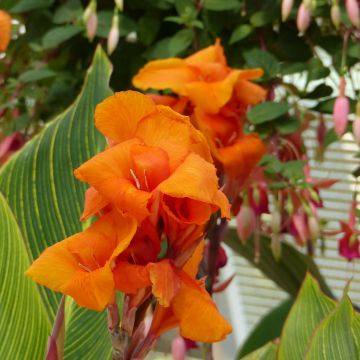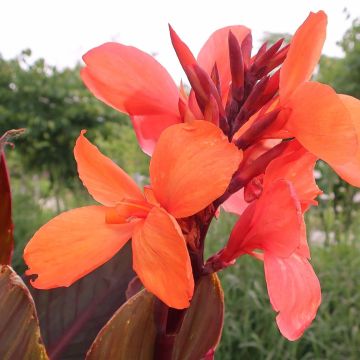

Canna Musifolia - Canna Lily


Canna Musifolia - Canna Lily
Canna Musifolia - Canna Lily
Canna musaefolia Musaefolia
Giant canna
I didn't receive the correct variety..... in 2019...... What a shame.........
cathy, 01/03/2020
Why not try an alternative variety in stock?
View all →This plant carries a 6 months recovery warranty
More information
We guarantee the quality of our plants for a full growing cycle, and will replace at our expense any plant that fails to recover under normal climatic and planting conditions.
From €5.90 for pickup delivery and €6.90 for home delivery
Express home delivery from €8.90.

Does this plant fit my garden?
Set up your Plantfit profile →
Description
Canna 'Musifolia' is a giant, possibly the largest species of canna on earth. Reaching heights of over 2.5m (8ft), it is a highly ornamental plant with immense leaves resembling those of a banana, with a matte green colour edged and veined in purple. It grows rapidly and is hardy down to -15°C (5°F) in well-drained soil, making it suitable for many regions. Even without flowers, it can find its place in an exotic and lush garden.
Canna 'Musifolia' is an herbaceous rhizomatous plant from the Cannaceae family. It is of uncertain origin, but is probably a native hybrid from Venezuela, introduced in France in 1858. It quickly forms a lush clump, sometimes reaching a height of 4m (13ft), occupying over 1m (3ft) of ground space. It produces large "banana" leaves, with a matte olive-green colour, dark red veins on the top, and purple margins. The leaves stand upright along sturdy reddish stems. The flowering occurs in summer, but only appears in warm regions or exposures. It takes the form of spikes of small orange to red flowers. The plant easily propagates vegetatively, producing numerous suckers.
Canna 'Musifolia' is ideal for gardeners who love tropical plants. It is perfect for regions that enjoy mild winters. It is very easy to cultivate if it receives enough water and nutrients during its growing season. It will survive winter without special protection in most regions. In a large bed, it can be paired, for example, with hardy banana plants such as Musa 'Sakhalin', M. velutina or M. ventricosa, Dahlia imperialis, Ricinus communis, kniphofia, Mahonia 'Soft Caress', agapanthus, Beschorneria yuccoides, or even Melianthus major. As a precaution, one or two rhizomes can be removed in autumn to protect them from extreme cold, or it can be grown in a large container on a patio, with appropriate watering and fertilising.
Report an error about the product description
Canna Musifolia - Canna Lily in pictures






Plant habit
Flowering
Foliage
Botanical data
Canna
musaefolia
Musaefolia
Cannaceae
Giant canna
South America
Other Cannas
Planting and care
Dig up the stumps when the first frost arrives or just before. Leave some soil around the roots, then store in a frost-free place, even if deprived of light. Divide the stumps in March, if necessary. Replant the divisions in pots, in a bright and heated area to start them off, then plant them in the garden when frost is no longer a concern. In recent years, due to the magnitude of the task, we have decided to leave the plants in the garden all year round. As soon as the first white frosts arrive, we cut back the foliage to the ground and then cover the stumps with a 15 to 20cm (6 to 8in) layer of straw or dead leaves. This mulching can be done in all regions. The important thing is that the frost should never reach the rhizomes that are just below the surface of the soil. We have seen that this method yields better results in our garden: the stumps are more robust, the plants are larger, and the flowering is more abundant.
Planting period
Intended location
Care
-
, onOrder confirmed
Reply from on Promesse de fleurs
Haven't found what you were looking for?
Hardiness is the lowest winter temperature a plant can endure without suffering serious damage or even dying. However, hardiness is affected by location (a sheltered area, such as a patio), protection (winter cover) and soil type (hardiness is improved by well-drained soil).

Photo Sharing Terms & Conditions
In order to encourage gardeners to interact and share their experiences, Promesse de fleurs offers various media enabling content to be uploaded onto its Site - in particular via the ‘Photo sharing’ module.
The User agrees to refrain from:
- Posting any content that is illegal, prejudicial, insulting, racist, inciteful to hatred, revisionist, contrary to public decency, that infringes on privacy or on the privacy rights of third parties, in particular the publicity rights of persons and goods, intellectual property rights, or the right to privacy.
- Submitting content on behalf of a third party;
- Impersonate the identity of a third party and/or publish any personal information about a third party;
In general, the User undertakes to refrain from any unethical behaviour.
All Content (in particular text, comments, files, images, photos, videos, creative works, etc.), which may be subject to property or intellectual property rights, image or other private rights, shall remain the property of the User, subject to the limited rights granted by the terms of the licence granted by Promesse de fleurs as stated below. Users are at liberty to publish or not to publish such Content on the Site, notably via the ‘Photo Sharing’ facility, and accept that this Content shall be made public and freely accessible, notably on the Internet.
Users further acknowledge, undertake to have ,and guarantee that they hold all necessary rights and permissions to publish such material on the Site, in particular with regard to the legislation in force pertaining to any privacy, property, intellectual property, image, or contractual rights, or rights of any other nature. By publishing such Content on the Site, Users acknowledge accepting full liability as publishers of the Content within the meaning of the law, and grant Promesse de fleurs, free of charge, an inclusive, worldwide licence for the said Content for the entire duration of its publication, including all reproduction, representation, up/downloading, displaying, performing, transmission, and storage rights.
Users also grant permission for their name to be linked to the Content and accept that this link may not always be made available.
By engaging in posting material, Users consent to their Content becoming automatically accessible on the Internet, in particular on other sites and/or blogs and/or web pages of the Promesse de fleurs site, including in particular social pages and the Promesse de fleurs catalogue.
Users may secure the removal of entrusted content free of charge by issuing a simple request via our contact form.
The flowering period indicated on our website applies to countries and regions located in USDA zone 8 (France, the United Kingdom, Ireland, the Netherlands, etc.)
It will vary according to where you live:
- In zones 9 to 10 (Italy, Spain, Greece, etc.), flowering will occur about 2 to 4 weeks earlier.
- In zones 6 to 7 (Germany, Poland, Slovenia, and lower mountainous regions), flowering will be delayed by 2 to 3 weeks.
- In zone 5 (Central Europe, Scandinavia), blooming will be delayed by 3 to 5 weeks.
In temperate climates, pruning of spring-flowering shrubs (forsythia, spireas, etc.) should be done just after flowering.
Pruning of summer-flowering shrubs (Indian Lilac, Perovskia, etc.) can be done in winter or spring.
In cold regions as well as with frost-sensitive plants, avoid pruning too early when severe frosts may still occur.
The planting period indicated on our website applies to countries and regions located in USDA zone 8 (France, United Kingdom, Ireland, Netherlands).
It will vary according to where you live:
- In Mediterranean zones (Marseille, Madrid, Milan, etc.), autumn and winter are the best planting periods.
- In continental zones (Strasbourg, Munich, Vienna, etc.), delay planting by 2 to 3 weeks in spring and bring it forward by 2 to 4 weeks in autumn.
- In mountainous regions (the Alps, Pyrenees, Carpathians, etc.), it is best to plant in late spring (May-June) or late summer (August-September).
The harvesting period indicated on our website applies to countries and regions in USDA zone 8 (France, England, Ireland, the Netherlands).
In colder areas (Scandinavia, Poland, Austria...) fruit and vegetable harvests are likely to be delayed by 3-4 weeks.
In warmer areas (Italy, Spain, Greece, etc.), harvesting will probably take place earlier, depending on weather conditions.
The sowing periods indicated on our website apply to countries and regions within USDA Zone 8 (France, UK, Ireland, Netherlands).
In colder areas (Scandinavia, Poland, Austria...), delay any outdoor sowing by 3-4 weeks, or sow under glass.
In warmer climes (Italy, Spain, Greece, etc.), bring outdoor sowing forward by a few weeks.















































